low oil pressure CHEVROLET CAVALIER 1995 3.G Owners Manual
[x] Cancel search | Manufacturer: CHEVROLET, Model Year: 1995, Model line: CAVALIER, Model: CHEVROLET CAVALIER 1995 3.GPages: 340, PDF Size: 17.09 MB
Page 121 of 340
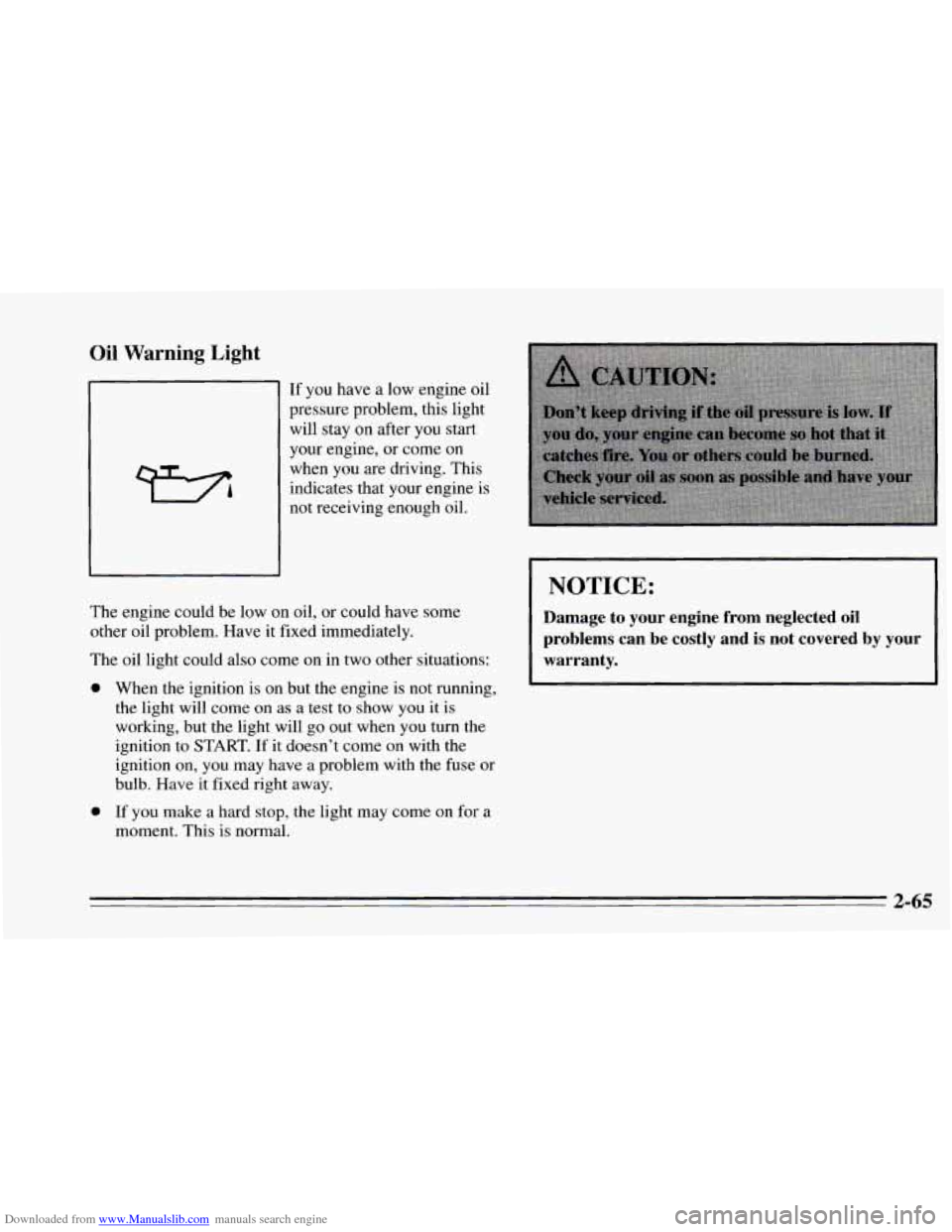
Downloaded from www.Manualslib.com manuals search engine Oil Warning Light
If you have a low engine oil
pressure problem, this light
will stay
on after you start
your engine, or come on
when you are driving. This
indicates that your engine is
not receiving enough oil.
The engine could be low on oil,
or could have some
other oil problem. Have it fixed immediately.
The oil light could also come on in two other situations:
0
0 When the ignition is on but the engine is not running,
the light will come on as a test to show
you it is
working, but the light will go out when you turn the
ignition to
START. If it doesn’t come on with the
ignition
on, you may have a problem with the fuse or
bulb. Have it fixed right away.
If you make a hard stop, the light may come on for a
moment. This is normal.
NOTICE:
Damage to your engine from neglected oil
problems can be costly and is not covered by your
warranty.
2-65
Page 159 of 340
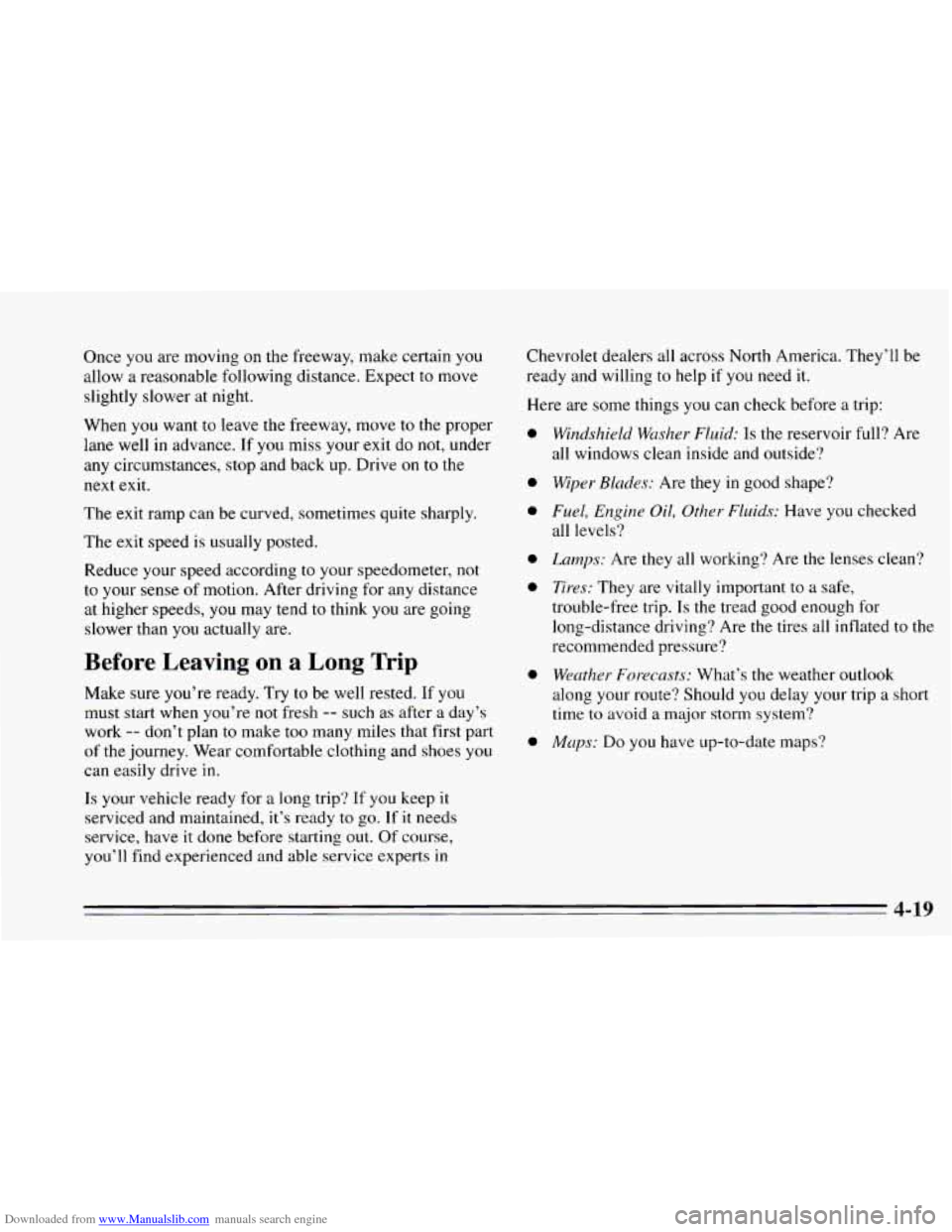
Downloaded from www.Manualslib.com manuals search engine Once you are moving on the freeway, make certain you
allow a reasonable following distance. Expect to move
slightly slower at night.
When you want to leave the freeway, move
to the proper
lane well
in advance. If you miss your exit do not, under
any circumstances, stop and back
up. Drive on to the
next exit.
The exit ramp can be curved, sometimes quite sharply.
The exit speed is usually posted.
Reduce your speed according
to your speedometer, not
to your sense of motion. After driving for any distance
at higher speeds, you may tend to think
you are going
slower than
you actually are.
Before Leaving on a Long Trip
Make sure you’re ready. Try to be well rested. If you
must start when you’re
not fresh -- such as after a day’s
work
-- don’t plan to make too many miles that first part
of the journey. Wear comfortable clothing and shoes
you
can easily drive in.
Is your vehicle ready for a long trip? If you keep it
serviced and maintained, it’s ready
to go. If it needs
service, have
it done before starting out. Of course,
you’ll find experienced and able service experts in Chevrolet dealers
all across North America. They’ll be
ready and willing to help
if you need it.
Here are some things you can check before a trip:
0
Windshield Washer Fluid: Is the reservoir full? Are
all windows clean inside and outside?
Wiper Blades: Are they in good shape?
Fuel, Engine Oil, Other Fluids: Have you checked
all levels?
Lanzps: Are they all working‘? Are the lenses clean?
Tires: They are vitally important to a safe,
trouble-free trip.
Is the tread good enough for
long-distance driving? Are the tires all inflated to the
recommended pressure?
Weather Forecasts: What’s the weather outlook
along your route? Should you delay your trip a short
time
to avoid a major storm system?
Maps: Do you have up-to-date maps?
4-19
Page 247 of 340
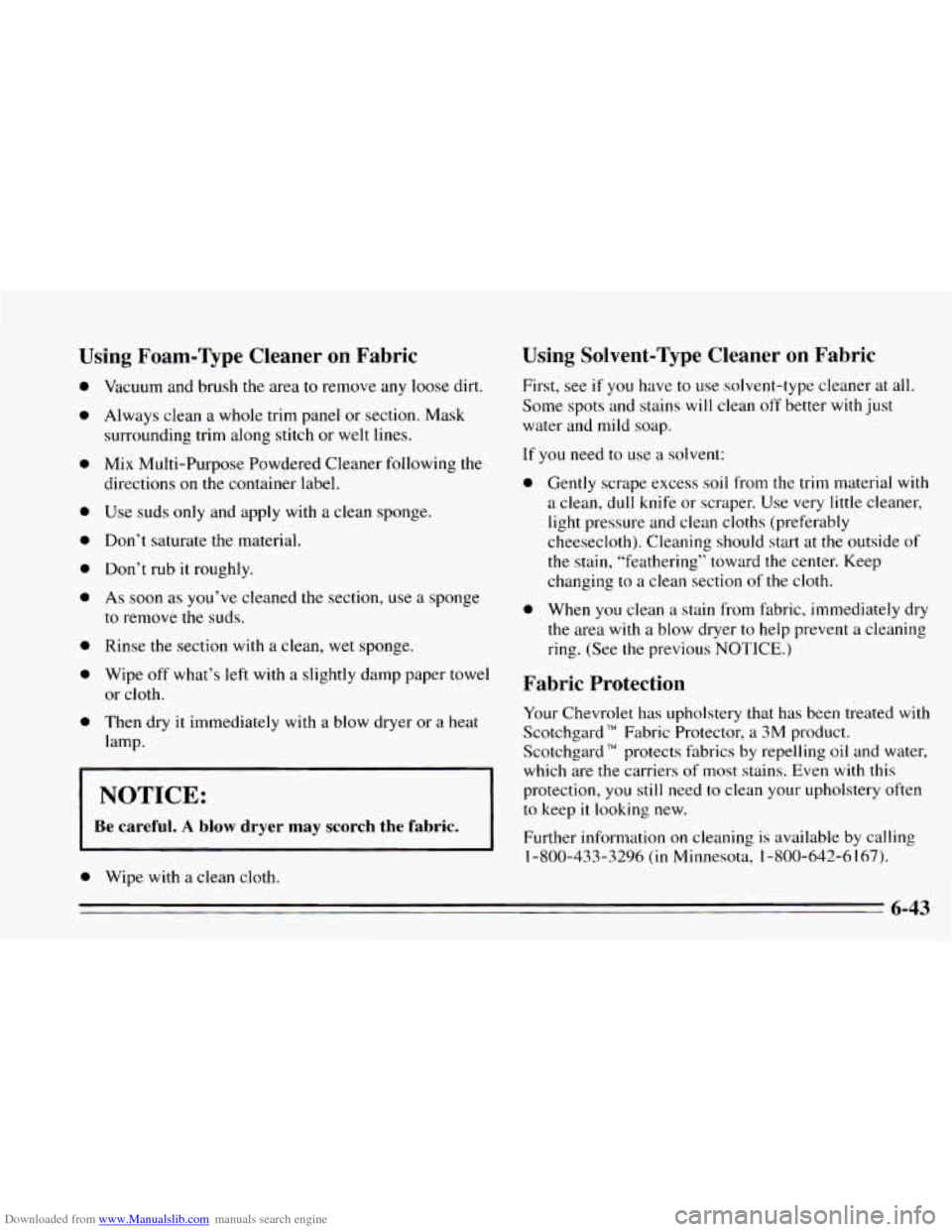
Downloaded from www.Manualslib.com manuals search engine Using Foam-Type Cleaner on Fabric
0
0
0
0
0
0
0
0
0
0
Vacuum and brush the area to remove any loose dirt.
Always clean a whole trim panel or section. Mask
surrounding trim along stitch or welt lines.
Mix Multi-Purpose Powdered Cleaner following the
directions
on the container label.
Use suds
only and apply with a clean sponge.
Don’t saturate the material.
Don’t rub
it roughly.
As soon as you’ve cleaned the section, use a sponge
to remove the suds.
Rinse
the section with a clean, wet sponge.
Wipe
off what’s left with a slightly damp paper towel
or cloth.
Then dry it immediately with a blow dryer or a heat
lamp.
NOTICE:
Be careful. A blow dryer may scorch the fabric.
~~~~ ~~ ~~
0 Wipe with a clean cloth.
Using Solvent-Type Cleaner on Fabric
First, see if you have to use solvent-type cleaner at all.
Some spots and stains will clean
off better with just
water and mild soap.
If you need to use a solvent:
0 Gently scrape excess soil from the trim material with
a clean, dull knife or scraper. Use very little cleaner,
light pressure and clean cloths (preferably
cheesecloth). Cleaning should start at
the outside of
the stain, “feathering” toward
the center. Keep
changing to
a clean section of the cloth.
0 When you clean a stain from fabric, immediately dry
the area with
a blow dryer to help prevent a cleaning
ring. (See the previous
NOTICE.)
Fabric Protection
Your Chevrolet has upholstery that has been treated with
Scotchgard
TM Fabric Protector, a 3M product.
Scotchgard” protects fabrics by repelling oil and water,
which are the carriers
of most stains. Even with this
protection,
you still need to clean your upholstery often
to keep
it looking new.
Further information on cleaning is available by calling
1-800-433-3296
(in Minnesota, 1-800-642-6 167).
6-43
Page 251 of 340
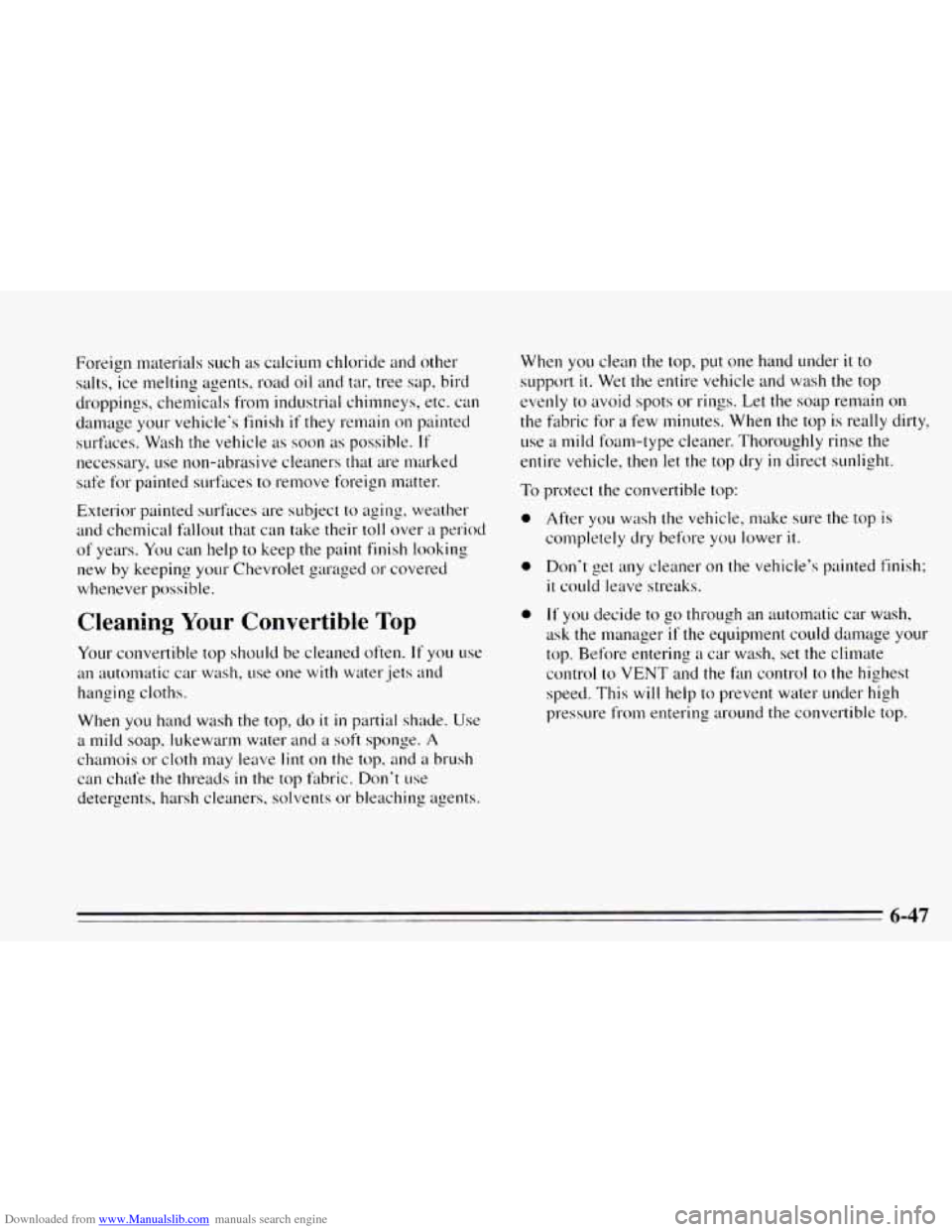
Downloaded from www.Manualslib.com manuals search engine Foreign materials such as calcium chloride and other
salts, ice melting agents, road
oil and tar, tree sap. bird
droppings, chemicals from industrial chimneys, etc. can
damage your vehicle's finish
if they remain on painted
surfaces.
Wash the vehicle as soon as possible. If
necessary, use non-abrasive cleaners that are marked
safe for painted surfices
to remove foreign matter.
Exterior painted surfaces are subject to aging, weather
and chemical fallout that can take their
toll over a period
of years. You can help to keep the paint finish looking
new by keeping your Chevrolet garaged or covered
whenever possible.
Cleaning Your Convertible Top
Your convertible top should be cleaned often. If you use
an automatic car
wash, use one with water jets and
hanging cloths.
When you hand wash the top,
do it in partial shade. Use
a mild soap, lukewarm water and
a soft sponge. A
chamois or cloth may leave lint on the top, and a brush
can chate the tllreads
in the top fabric. Don't use
detergents, harsh cleaners, solvents or bleaching agents. When you
clean the top, put one hand under it
to
support it. Wet the entire vehicle and wilsh the top
evenly to avoid spots or rings. Let the soap remain
on
the fabric for a few minutes. When the top is really dirty,
use a mild foam-type cleaner. Thoroughly rinse the
entire vehicle,
then let the top dry in direct sunlight.
To protect the convertible top:
0 After you wash the vehicle, make sure the top is
completely
dry before you lower it.
0 Don't get any cleaner on the vehicle's painted finish:
it could leave streaks.
0 It' you decide to go through an automatic car wash,
ask the manager
if the equipment could damage your
top. Before entering
a car wash, set the climate
control
to VENT and the fan control to the highest
speed. This
will help to prevent water under high
pressure
from entering around the convertible top.
6-47
Page 300 of 340
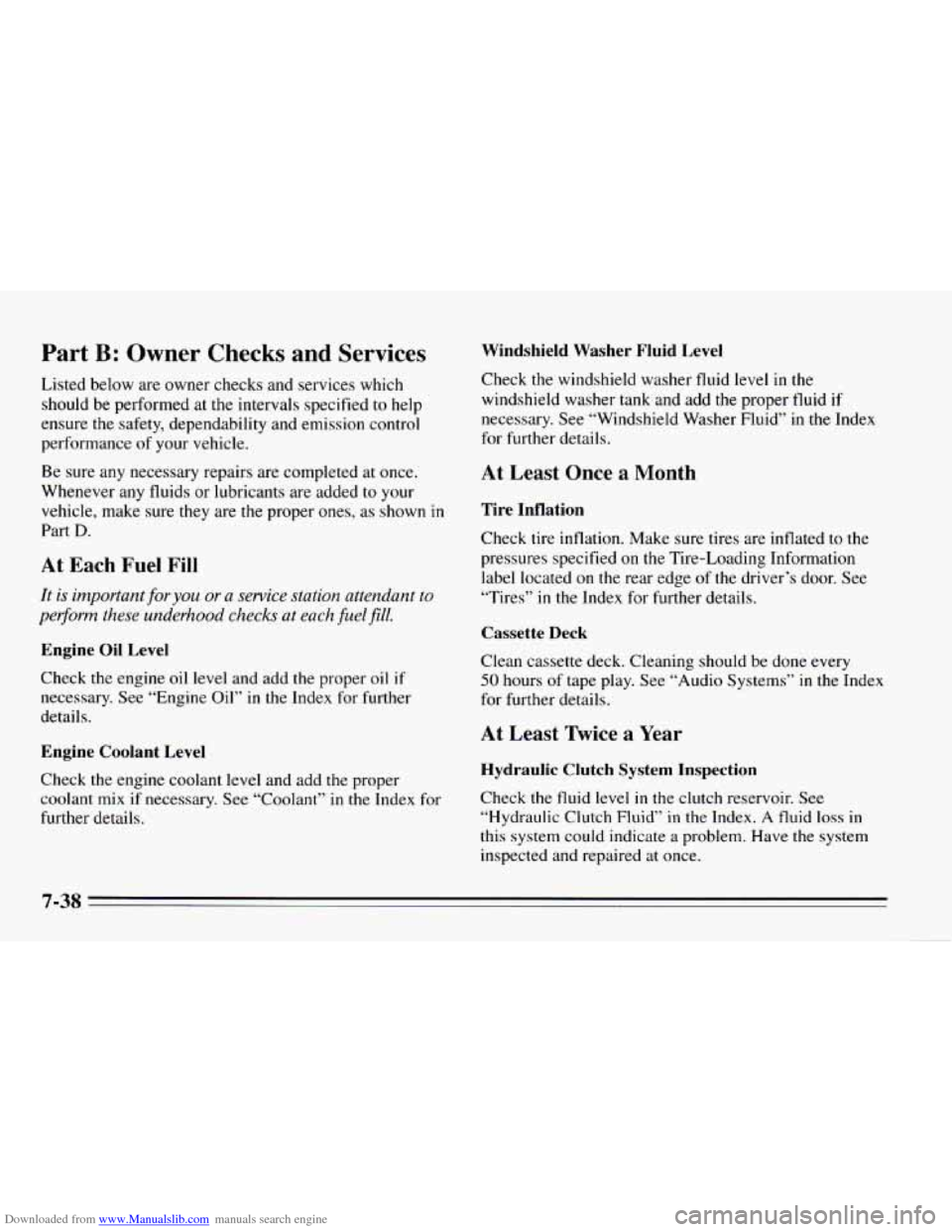
Downloaded from www.Manualslib.com manuals search engine Part B: Owner Chews and Services
Listed below are owner checks and services which
should be performed at the intervals specified to help
ensure the safety, dependability and emission control
performance of your vehicle.
Be sure any necessary repairs are completed at once.
Whenever any fluids or lubricants are added
to your
vehicle, make sure
they are the proper ones, as shown in
Part D.
At Each Fuel Fill
It is important for you or a service station attendant to
pe$orm these underhood checks at each fuel fill.
Engine Oil Level Windshield Washer Fluid Level
Check the windshield washer fluid level
in the
windshield washer tank and add the proper fluid
if
necessary. See “Windshield Washer Fluid” in the Index
for further details.
At Least Once a Month
Tire Inflation
Check tire inflation. Make sure tires are inflated to the
pressures specified on the Tire-Loading Information
label located
on the rear edge of the driver’s door. See
“Tires”
in the Index for further details.
Cassette Deck
Clean cassette deck. Cleaning should be done every
50 hours of tape play. See “Audio Systems’’ in the Index
for further details.
Check the engine oil level
and add the proper oil if
necessary. See “Engine Oil” in the Index for further
details.
At Least Twice a Year
Engine Coolant Level
Check the engine coolant level and add the proper
coolant mix if necessary. See “Coolant”
in the Index for
further details.
Hydraulic Clutch System Inspection
Check the fluid level in the clutch reservoir. See
“Hydraulic Clutch Fluid“ in the Index.
A fluid loss in
this system could indicate
a problem. Have the system
inspected and repaired at once.
7-38